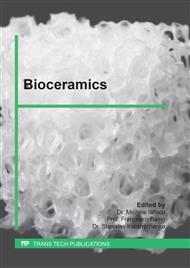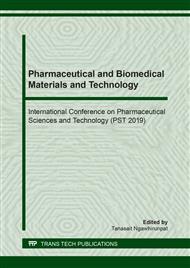p.3
p.9
p.15
p.21
p.27
p.33
p.38
p.45
Porous Hydroxyapatite/Chitosan/Carboxymethyl Cellulose Scaffolds with Tunable Microstructures for Bone Tissue Engineering
Abstract:
Bone tissue engineering is an alternative approach to generate bone using biomaterials and cells. Hydroxyapatite (HA) has good biocompatibility, osteoinductivity, and osteoconductivity. However, it has limited utility due to poor mechanical properties and slow degradation rate. To improve mechanical properties and to modify degradation profile, hydroxyapatite was tethered in chitosan (CS) and carboxymethyl cellulose (CMC) complex. Gelatin was incorporated to promote cell attachment and polyvinyl alcohol (PVA) was used to improve mechanical strength of this scaffold. The physico-mechanical and biological properties of these scaffolds were investigated. Fourier transform infrared (FTIR) analysis and X-ray diffraction (XRD) showed the incorporation of hydroxyapatite in polymer matrix. The scaffolds had density, compressive strength, and Young’s modulus in the range of 0.24-0.30 g/cm3, 0.028-0.035 MPa, 0.178-0.560 MPa, respectively. The scaffolds had porosity of 69-91 percent. Higher content of PVA decreased porosity of scaffolds. Scanning electron microscope showed porous microstructure with pore size in the range of 60-183 μm. In vitro test on MC3T3-E1 preosteoblast cells showed negligible cytotoxicity of scaffolds. The data suggested that HA/CS/CMC/gelatin/PVA scaffold has potential applications in bone tissue engineering.
Info:
Periodical:
Pages:
9-14
Citation:
Online since:
August 2019
Price:
Сopyright:
© 2019 Trans Tech Publications Ltd. All Rights Reserved
Share:
Citation:



